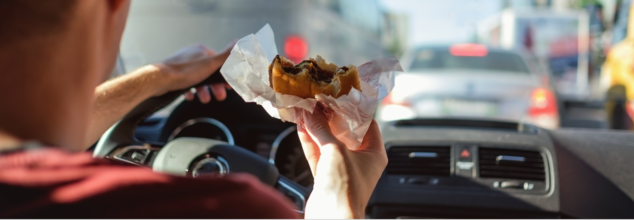
Image Credit: Canva
Traffic Jams Lead To Unhealthy Cravings And Fast Food Habits, Study Reveals
Recent research conducted at the University of Illinois at Urbana-Champaign has recently uncovered a potential relationship between traffic congestion and poor eating habits, including a growing tendency to eat fast food. The study published in the Journal of Urban Economics explores how delayed traffic can lead to dietary choice and, as such, presents a significant impact on public health.
Based on the existing notorious heavy traffic within Los Angeles County, researchers combined data for over two years from daily traffic data and cell phone usage statistics to monitor visits to fast food establishments. The authors found that anomalous traffic delays, above normal congestion levels, led to a significant increase in visits to fast food outlets. In fact, this study suggests that a 30-second delay per mile is associated with an increase of 1% in fast food consumption, or about 1.2 million additional fast food visits annually within the county. The study indicated that traffic-induced fast food consumption effects were particularly evident during the peak evening rush-hour period between 5 and 7 p.m.
At this point, drivers, having been at work and eager to return home, are more likely to seek out fast food convenience rather than to cook a meal or go grocery shopping. It illustrates how busy and stressful it can be during this time to make impulse choices about food. Although the study was focused on Los Angeles, its findings apply broadly to any city in the world where traffic congestion is prevalent. The persistent fast food presence on highways and cities makes it conceivable that this phenomenon is observed in other locations. This has broader implications in the global health domain because consumption of fast food has been associated with a plethora of health disorders such as obesity, cardiovascular diseases, and diabetes.
Are There Any Underlying Causes for Such Habits?
Several factors contribute to the tendency to choose fast food during traffic delays:
Time Scarcity: Extended time spent in traffic reduces the time available for meal preparation, making the quick service of fast food more appealing.
Stress and Fatigue: Navigating through heavy traffic can lead to increased stress and fatigue, which have been linked to cravings for high-calorie, comfort foods.
Convenience: Strategically placing fast food shops along highways and busier intersections provides easy accessibility for the driver to quickly eat.
How to Manage Poor Eating Patterns and Cravings?
Traffic Congestion and Poor Eating Pattern Link Overall requires solving on multiple angles:
Infrastructure Investment in the City: Looking to reduce traffic congestion would save the scrounge of time, so perhaps that dependency on fast food will also be reduced.
Promoting Healthy Eating Habits: Encouraging individuals to plan meals ahead and prepare healthy snacks can help resist the temptation of fast food during delays.
Mindful Eating Practices: Being aware of hunger cues and making conscious food choices can prevent impulsive eating driven by stress or convenience.
Stress Management: Stress reduction techniques, like deep breathing exercises and listening to relaxing music while commuting might reduce the urge to seek comfort through unhealthy food consumption.
Public Health Campaigns: Sensitization towards public knowledge concerning the impact of traffic-induced stress on eating habits may empower them to create healthier eating options for themselves.
The study helps one understand how little things, like traffic congestion, subtly and yet significantly influence daily dietary behaviors. With such an understanding, it becomes easier for individuals and policymakers to come up with strategies to encourage healthier eating habits, even in the midst of the difficulties of urban living.
© 2024 Bennett, Coleman & Company Limited

